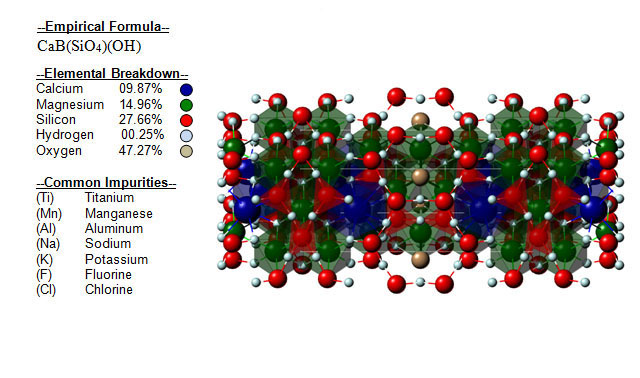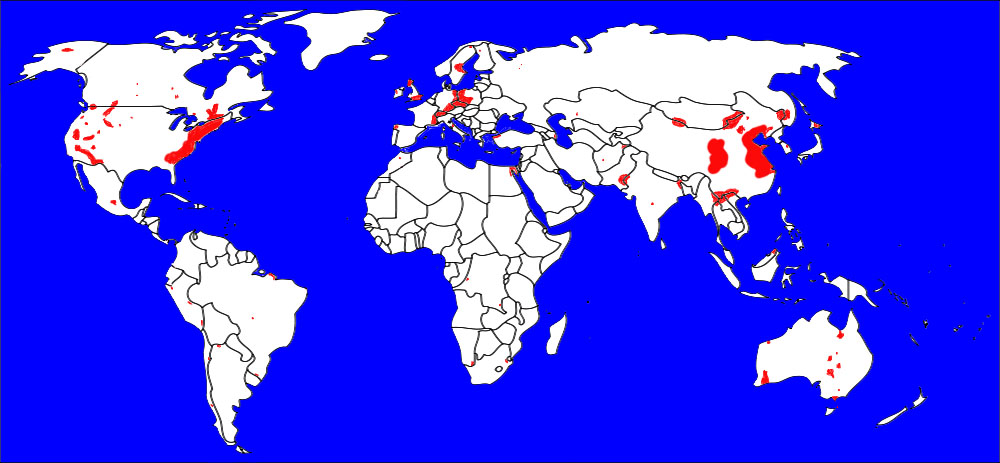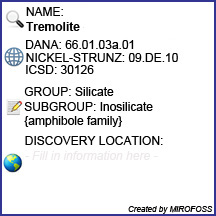

| Mineral Name | Tremolite |
| First Discovered | 1790 |
| Nickel-Strunz Classification | 09.DE.10 |
| Dana Classification | 66.01.03a.01 |
| ICSD | 30126 |
| Mineral Group | Silicates |


| Cleavage | Perfect, Distinct |
| Colour(s) | Colourless, Brown, Gray, White, Light green |
| Specific Gravity | 3.05 |
| Diaphaneity | Transparent to Translucent |
| Fracture | Sub Conchoidal - Fractures developed in the brittle materials characterized by semi-curving surfaces |
| Mohs Hardness | 5.0 to 6.0 |
| Luminescence | Fluorescent, Short UV - yellow, Long UV - pink |
| Luster | Vitreous to Pearly |
| Streak | White |
| Habit(s) | Columnar to Massive fibrous to Massive granular |
| Radioactivity | Non-radioactive |
| Magnetism | Non-magnetic |

The following health hazards should be noted when handling tremolite:
 |
BIOHAZARD Tremolite can cause asbestosis, lung cancer, and both pleural and peritoneal mesothelioma. |

The following image shows the Elemental breakdown of the mineral tremolite along with the mineral crystal structure.


| Crystal System | Monoclinic |  |
| Class | Prismatic | |
| Axial Ratios | a : b : c = 0.5449 : 1 : 0.2923 | |
| Morphology | Elongated, stout prismatic, bladed crystals | |
| Optical Data Type | Biaxial (-) | |
| Pleochroism (x) | Colourless | |
| Pleochroism (y) | Colourless | |
| RL Values | nα = 1.599 - 1.612 nβ = 1.613 - 1.626 nγ = 1.625 - 1.637 | |
| 2V | Measured: 88° to 80°, Calculated: 82° to 84° |  |
| Max Birefringence | δ = 0.026 (See colour chart at right) | |
| Surface Relief | Moderate | |
| Dispersion | Weak r < v | |

Tremolite can be referenced in certain current and historical texts under the following seven names:
The mineral tremolite can be translated into the following select languages:
| Arabic | الترموليت | Bulgarian | тремолита | Chinese (Sim) | 透闪石 |
| Croatian | tremolit | Czech | Tremolit | Danish | Tremoliet |
| Dutch | tremoliet | Esperanto | Estonian | tremoliiti | |
| Finnish | Tremoliitti | French | Trémolite | German | Tremolith |
| Greek | τρεμολίτης | Hebrew | טרמוליט | Hungarian | tremolit |
| Italian | Japanese | 透閃石 | Korean | 트레 | |
| Latin | Lithuanian | tremolitas | Norwegian | ||
| Persian | ترمولیت | Polish | Tremolit | Portuguese | tremolita |
| Romanian | tremolit | Russian | Тремолит | Slovak | Tremolit |
| Spanish | Tremolita | Swedish | tremolit | Tagalog | |
| Turkish | tremolitlere | Ukrainian | тремоліт | Vietnamese |

tremolite can be found in many places around the world. The map below shows major documented concentrations of tremolite:


 |
The MIROFOSS database offers free printable geological identification tags for personal and non-profit use. These tags can be used to properly identify mineral samples in your collection. -Click here- to download a full size jpeg image for a tremolite identification tag; which can be printed on paper or used with a plastic laser printer. |
 |
What's this? What can I do with it? |

| Chemical Composition | Hawthorne, F.C. and Grundy, H.D. (1976) The crystal chemistry of the amphiboles; IV, X-ray and neutron refinements of the crystal structure of tremolite. Canadian Mineralogist: 14: 334-345. |
| Crystallography | Hawthorne, F.C., Della Ventura, G., and Robert, J.-L. (1996) Short-range order of (Na,K) and Al in tremolite: An infrared study. American Mineralogist: 81: 782-784. |
| Crystallography | Ishida, K. Hawthorne, F.C., and Ando, Y. (2002) Fine structure of infrared OH-stretching bands in natural and heat-treated amphiboles of the tremolite-ferroactinolite series. American Mineralogist: 87: 891-898. |
| History | Hawthorne, F. C. and Oberti, R. (2006): On the classification of amphiboles. Canadian Mineralogist 44, 1-21. |
| Geograpcial Data | Mindat.org. Retrieved on 2012-04-26 |
| Physical Identification | Webmineral.com. Retrieved on 2012-04-26. |
| Nover 28, 2013 | The last time this page was updated |
| ©2017 MIROFOSS™ Foundation | |
 |